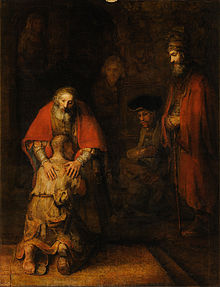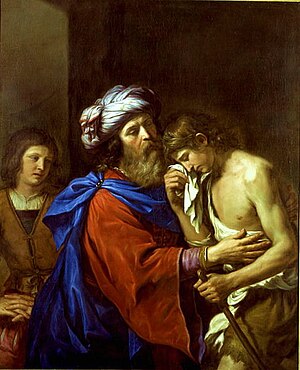Parable
A parable is a succinct, didactic story, in prose or verse that illustrates one or more instructive lessons or principles. It differs from a fable in that fables employ animals, plants, inanimate objects, or forces of nature as characters, whereas parables have human characters.[1] A parable is a type of analogy.[2]
Some scholars of the canonical gospels and the New Testament apply the term "parable" only to the parables of Jesus,[3][4] though that is not a common restriction of the term. Parables such as "The Prodigal Son" are central to Jesus's teaching method in the canonical narratives and the apocrypha.
History[edit]
Parables are often used to explore ethical concepts in spiritual texts. The Bible contains numerous parables in the Gospels section of the New Testament (Jesus's parables). These are believed by some scholars (such as John P. Meier) to have been inspired by mashalim, a form of Hebrew comparison.[4] Examples of Jesus' parables include the Good Samaritan and the Prodigal Son. Mashalim from the Old Testament include the parable of the ewe-lamb (told by Nathan in 2 Samuel 12:1-9[6]) and the parable of the woman of Tekoah (in 2 Samuel 14:1-13 [7]).
Parables also appear in Islam. In Sufi tradition, parables are used for imparting lessons and values. Recent authors such as Idries Shah and Anthony de Mello have helped popularize these stories beyond Sufi circles.
Modern parables also exist. A mid-19th-century example, the Parable of the broken window, criticises a part of economic thinking.
Esoteric writings and objects[edit]
The word "apocryphal" (ἀπόκρυφος) was first applied[by whom?] to writings which were kept secret [8] because they were the vehicles of esoteric knowledge considered too profound or too sacred to be disclosed to anyone other than the initiated. For example, the disciples of the Gnostic Prodicus boasted that they possessed the secret (ἀπόκρυφα) books of Zoroaster. The term in general enjoyed high consideration among the Gnostics (see Acts of Thomas, pp. 10, 27, 44).[9]
Writings of questionable value[edit]
"Apocrypha" was also applied to writings that were hidden not because of their divinity but because of their questionable value to the church. Many in Protestant traditions cite Revelation 22:18–19 as a potential curse for those who attach any canonical authority to extra-biblical writings such as the Apocrypha. However, a strict explanation of this text would indicate it was meant for only the Book of Revelation. Rv.22:18–19f. (KJV) states: "For I testify unto every man that heareth the words of the prophecy of this book, If any man shall add unto these things, God shall add unto him the plagues that are written in this book: And if any man shall take away from the words of the book of this prophecy, God shall take away his part out of the book of life, and out of the holy city, and from the things which are written in this book." In the context of Revelation, a book predicting the future atrocities of man, it means that God will strip them of the goodness of life ("from the things written in this book") and that they will be removed from heaven ("out of the book of life"). The early Christian theologian Origen, in his Commentaries on Matthew, distinguishes between writings which were read by the churches and apocryphal writings: γραφὴ μὴ φερομένη μέν ἒν τοῖς κοινοῖς καὶ δεδημοσιευμένοις βιβλίοις εἰκὸς δ' ὅτι ἒν ἀποκρύφοις φερομένη (writing not found on the common and published books in one hand, actually found on the secret ones on the other).[11] The meaning of αποκρυφος is here practically equivalent to "excluded from the public use of the church", and prepares the way for an even less favourable use of the word.[9]
Spurious writings[edit]
In general use, the word "apocrypha" came to mean "false, spurious, bad, or heretical." This meaning also appears in Origen's prologue to his commentary on the Song of Songs, of which only the Latin translation survives: De scripturis his, quae appellantur apocriphae, pro eo quod multa in iis corrupta et contra fidem veram inveniuntur a maioribus tradita non placuit iis dari locum nec admitti ad auctoritatem.[9] "Concerning these scriptures, which are called apocryphal, for the reason that many things are found in them corrupt and against the true faith handed down by the elders, it has pleased them that they not be given a place nor be admitted to authority."
Etymology[edit]
The word parable comes from the Greek παραβολή (parabolē), meaning "comparison, illustration, analogy."[5] It was the name given by Greek rhetoricians to an illustration in the form of a brief fictional narrative.
History[edit]
Parables are often used to explore ethical concepts in spiritual texts. The Bible contains numerous parables in the Gospels section of the New Testament (Jesus's parables). These are believed by some scholars (such as John P. Meier) to have been inspired by mashalim, a form of Hebrew comparison.[4] Examples of Jesus' parables include the Good Samaritan and the Prodigal Son. Mashalim from the Old Testament include the parable of the ewe-lamb (told by Nathan in 2 Samuel 12:1-9[6]) and the parable of the woman of Tekoah (in 2 Samuel 14:1-13 [7]).
Friedrich Gustave Lisco 1850 The Parables of Jesus Daniels and Smith Publishers, Philadelphia pages 9–11
Parables also appear in Islam. In Sufi tradition, parables are used for imparting lessons and values. Recent authors such as Idries Shah and Anthony de Mello have helped popularize these stories beyond Sufi circles.
Modern parables also exist. A mid-19th-century example, the Parable of the broken window, criticises a part of economic thinking.
Parables of Jesus
| Events in the |
| Life of Jesus according to the Gospels |
|---|
 |
|
|
The Parables of Jesus are found in the Synoptic Gospels and some of the non-canonical gospels. They form approximately one third of his recorded teachings. Christians place great emphasis on these parables; which they regard as the words of Jesus, they are believed to be what the Father has taught, indicated by John 8:28 and 14:10.[1][2]
Jesus's parables are seemingly simple and memorable stories, often with imagery, and all convey messages. Scholars have commented that although these parables seem simple, the messages they convey are deep, and central to the teachings of Jesus. Christian authors view them not as mere similitudes which serve the purpose of illustration, but as internal analogies in which nature becomes a witness for the spiritual world.[3][4]
Many of Jesus's parables refer to simple everyday things, such as a woman baking bread (parable of the Leaven), a man knocking on his neighbor's door at night (parable of the Friend at Night), or the aftermath of a roadside mugging (parable of the Good Samaritan); yet they deal with major religious themes, such as the growth of the Kingdom of God, the importance of prayer, and the meaning of love.
Characteristics[edit]
A parable is a short tale that illustrates a universal truth; it is a simple narrative. It sketches a setting, describes an action, and shows the results. It may sometimes be distinguished from similar narrative types, such as the allegory and the apologue.[8]
A parable often involves a character who faces a moral dilemma or one who makes a bad decision and then suffers the unintended consequences. Although the meaning of a parable is often not explicitly stated, it is not intended to be hidden or secret but to be quite straightforward and obvious.[9]
The defining characteristic of the parable is the presence of a subtext suggesting how a person should behave or what he should believe. Aside from providing guidance and suggestions for proper conduct in one's life, parables frequently use metaphorical language which allows people to more easily discuss difficult or complex ideas. Parables express an abstract argument by means of using a concrete narrative which is easily understood.
The allegory is a more general narrative type; it also employs metaphor. Like the parable, the allegory makes a single, unambiguous point. An allegory may have multiple noncontradictory interpretations and may also have implications that are ambiguous or hard to interpret. As H.W. Fowler put it, the object of both parable and allegory "is to enlighten the hearer by submitting to him a case in which he has apparently no direct concern, and upon which therefore a disinterested judgment may be elicited from him, ..."[8] The parable is more condensed than the allegory: it rests upon a single principle and a single moral, and it is intended that the reader or listener shall conclude that the moral applies equally well to his own concerns
Jesus' parables[edit]
Medieval interpreters of the Bible often treated Jesus' parables as allegories, with symbolic correspondences found for every element in his parables. But modern scholars, beginning with Adolf Jülicher, regard their interpretations as incorrect.[3] Jülicher held that Jesus' parables are intended to make a single important point, and most recent scholarship agrees.[4]
Adolf Jülicher, Die Gleichnisreden Jesu (2 vols; Tübingen: Mohr [Siebeck], 1888, 1899).
Gnostics suggested that Jesus kept some of his teachings secret within the circle of his disciples and that he deliberately obscured their meaning by using parables. For example, in Mark 4:11–12:
Gnosticism (from Ancient Greek: γνωστικός gnostikos, "having knowledge", from γνῶσις gnōsis, knowledge) is a modern name for a variety of ancient religious ideas and systems, originating in Jewish-Christian milieux in the first and second century AD. These systems believed that the material world is created by an emanation or 'works' of a lower god (demiurge), trapping the divine spark within the human body. This divine spark could be liberated by gnosis, spiritual knowledge acquired through direct experience. Some of the core teachings include the following:
- All matter is evil, and the non-material, spirit-realm is good.
- There is an unknowable God, who gave rise to many lesser spirit beings called Aeons.
- The creator of the (material) universe is not the supreme god, but an inferior spirit (the Demiurge).
- Gnosticism does not deal with "sin," only ignorance.
- To achieve salvation, one needs gnosis (knowledge).
The Gnostic ideas and systems flourished in the Mediterranean world in the second century AD, in conjunction with and influenced by the early Christian movements and Middle Platonism. After the second century, a decline set in. In the Persian Empire, Gnosticism in the form of Manicheism spread as far as China, while Mandaeism is still alive in Iraq.
A major question in scholarly research is the qualification of Gnosticism, based on the study of its texts, as either an interreligious phenomenon or as an independent religion.
d because the readers assume they are the same parable. In cases like these, a reader should print out the scriptures and study them side-by-side and word-by-word to note the differences, and find the hidden meanings through those differences. One most noted example is the Parable of the Minas (Luke 19:12-27) and Parable of the Talents (Matthew 25:14-30). A book is devoted to the exploration of these differences which reveal to readers God's expectations of Christians regarding their time (the minas in Luke 19) and their talents (the large sums of money in Matthew 25).[38]


